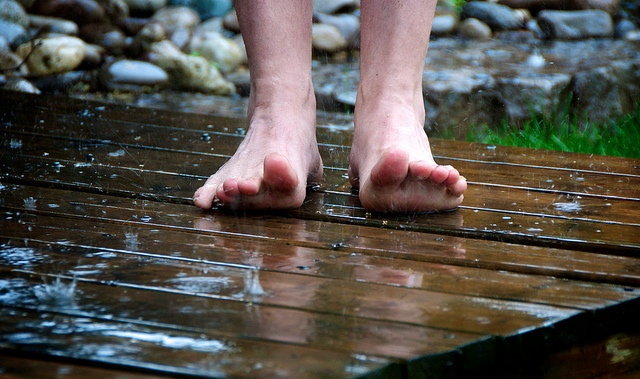[dropcap size=dropcap-big]W[/dropcap]ithin the running community, there are very few absolute truths. The same diet doesn\’t work for everybody. Not all runners get faster on a schedule of high mileage. Some people stretch before and after every run; others only stretch when they bend over to tie their shoes.
One constant, though, is that if you run, you\’ve been hurt. Minor aches or major pains, we\’ve all felt the sting of \”too much, too far, too fast, too soon.\”
What if there were a way to eliminate these injuries without buying fancy shoes, getting weekly preventive care, or seeing an orthopedist? Christopher McDougall, author of Born to Run: A Hidden Tribe, Superathletes, and the Greatest Race the World has Never Seen, thinks he has the solution.
\”In my early 40s, I got rid of my shoes — and my ailments went away too,\” he proclaimed in a 2011 TED Talk.
His talk (and book) describe a Mexican tribe filled with people — young and old — who can run distances upwards of 100 miles with no modern shoes. They also exhibit none of the running injuries that are typical of runners in developed societies.
\”[In folklore] running is always associated with freedom and vitality and youthfulness and eternal vigor,\” he says. \”It\’s only in our lifetime that running has become associated with fear and pain.\”
[dropcap size=dropcap]D[/dropcap]oes that mean you should ditch your shoes the next time you run? Well, probably not. As much as runners experience injury already, the numbers actually increase when people start going barefoot.
Why? Because we\’re runners, and if we\’re not setting personal bests, we\’re going to run longer, faster, more often until we see improvement. Unfortunately, that leads to another case of \”too much, too far, too fast, too soon.\”
\”If we never put a pair of shoes on, our bodies would have developed differently,\” says Randy Whorton, the Director of Wild Trails. \”It is becoming obvious to the running industry that by stopping wearing shoes overnight and running barefoot, your chances of injury are likely to increase. What I do subscribe to this barefoot running movement is the form.
\”If you take your shoes off and run on a grass surface, the natural tendency is to land your foot flat of even landing first on your forefoot. This has been argued successfully that this is more natural and healthy than to land first on your heel. I suggest following this \’barefoot-style\’ form — but do it with shoes on.\”
Shoes, after all, provide protection from the concrete, glass and metal that are foreign to our tribal forebearers. Elements of trail races like freezing temperatures, sharp rocks, and thorns are also dangerous — even though they\’re \”all natural.\” So consider your surroundings before denuding your feet.
[dropcap size=dropcap]H[/dropcap]ow do we find out if we\’re truly \”born to run\” if going barefoot is also cautioned against?
Start slowly. At the end of your run, find some soft grass, take off your shoes and trot around for 30 seconds or a minute. If it feels good, stop! Have patience. Otherwise, you\’re likely to overdo it and give up — before you ever get to really experience the potential benefits.
Do the same thing after your next few runs. Maybe run as much as 5 minutes, if your body is telling you that it\’s OK. Learn what running \”naturally\” feels like…then put on your shoes and keep doing it, bumping up the mileage a few minutes at a time. (The 10% rule applies here.)
And to McDougall\’s credit, he also offers a few other explanations for why the Tarahumara run so successfully:
- They\’re part of a cooperative group. When they run for a purpose, everybody benefits.
- They\’re playful. Most of their running is done in the form of games and friendly competition — not punishment.
- They\’re the same as they\’ve always been. That is, they didn\’t try to monetize new shoe technology and change their way of life overnight, evolutionarily speaking.
Bottom line: Shoes may or may not be the enemy. The jury is still out — and will be for a long time. But shoes definitely shouldn\’t feel like foam rubber prisons.
So run because it makes you happy. Run because you want to see the world and all it has to offer. Run because you were born to run.

